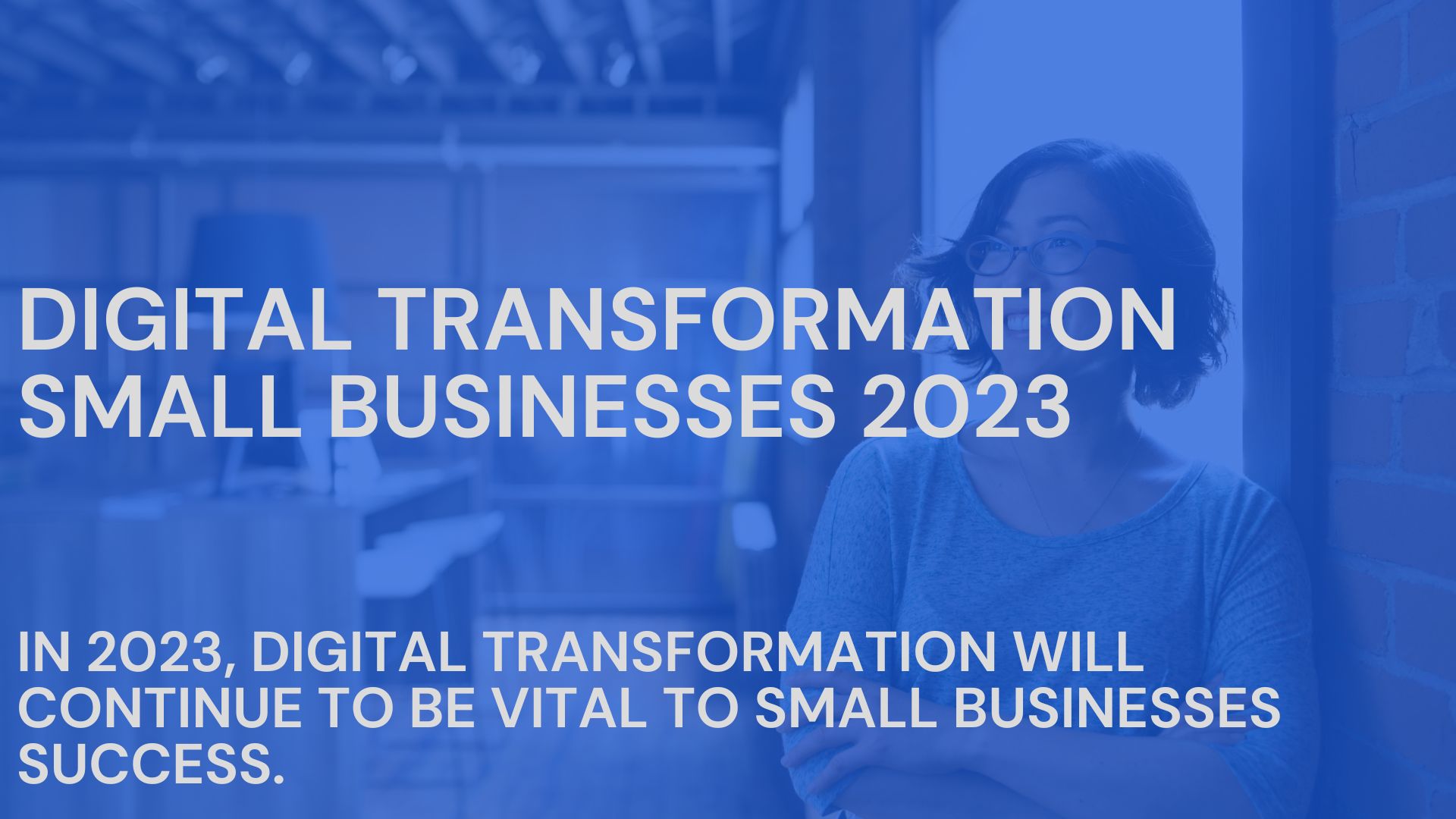The Crucial Role of Digital Transformation for Small Businesses in 2023
If you’re a small business owner, you’re likely aware of the ever-evolving landscape of technology and how it can impact your business. In 2023, digital transformation will continue to be vital to small businesses success. As technology continues to reshape industries and consumer behavior, embracing digital transformation has become a strategic imperative for small businesses to succeed and maintain their competitiveness.
Digital transformation refers to integrating digital technology into all business areas, fundamentally changing how businesses operate and deliver value to customers. In 2023, digital transformation will be a key growth driver for small businesses. By leveraging digital technologies, small businesses can streamline operations, improve customer experiences, and increase revenue. However, it’s important to note that digital transformation is not a one-time event but an ongoing process that requires continuous investment and adaptation to stay ahead of the competition.
The Benefits of Digital Transformation for Small Businesses
Implementing digital transformation can bring numerous benefits to small businesses. Here are some of the most significant advantages of digital transformation:
Increased Efficiency and Productivity
Digital transformation can help small businesses streamline their operations and improve efficiency. Automating manual processes and utilizing digital tools can reduce the time and resources required to complete tasks. For example, project management software can help you track progress and collaborate with team members more effectively.
Improved Customer Experience
Digital transformation can help small businesses provide a better customer experience. By leveraging digital technologies, you can offer your customers more personalized and convenient services. For example, implementing a customer relationship management (CRM) system can help you keep track of customer interactions and preferences, allowing you to provide more targeted and relevant offers.
New Revenue Streams
Digital transformation can open up new revenue streams for small businesses. You can reach new customers and markets by leveraging digital channels and technologies. For example, implementing an e-commerce platform can help you sell your products or services online, reaching customers beyond your local area.
Competitive Advantage
Digital transformation can provide small businesses with a competitive advantage. By embracing digital technologies and processes, you can differentiate yourself from competitors and stay ahead of industry trends. For example, data analytics can help you make more informed business decisions and stay ahead of market shifts.
In conclusion, digital transformation can benefit small businesses significantly, including increased efficiency and productivity, improved customer experience, new revenue streams, and competitive advantage. By embracing digital technologies and processes, small businesses can stay ahead of the curve and thrive in today’s digital economy.

Digital Transformation Strategies for Small Businesses
To successfully implement digital transformation in your small business, you must have a clear strategy. Here are some key steps to develop a digital transformation strategy that works for your business.
Assessing Your Current Processes
The first step in any digital transformation strategy is to assess your current processes. This involves identifying areas where you can improve efficiency and productivity by digitizing manual processes. Look for bottlenecks in your workflows, and identify areas where you can streamline processes by automating tasks or using digital tools.
Identifying Key Technologies
Once you have identified areas for improvement, the next step is to identify the key technologies that can help you achieve your digital transformation goals. This may involve investing in new software, hardware, or cloud-based solutions. Consider the cost of each technology, the potential return on investment (ROI) and the impact on your business operations.
Developing a Digital Culture
Digital transformation is not just about technology but also about creating a digital culture within your organization. This means fostering a mindset of innovation and agility and encouraging employees to embrace new technologies and working methods. It also means investing in training and development programs to help employees build the skills they need to thrive in a digital environment.
Building Agile Workflows
Finally, to ensure that your digital transformation efforts are successful, you must build agile workflows that adapt to changing business needs. This means breaking down silos and creating cross-functional teams collaborating effectively on digital projects. It also means adopting agile methodologies like Scrum or Kanban, prioritizing flexibility and adaptability.
Following these digital transformation strategies can build a strong foundation for long-term success in the digital age.
Overcoming Challenges in Digital Transformation
Digital transformation is not easy and can be especially challenging for small businesses. However, staying competitive and adapting to the ever-changing business landscape is crucial. Here are some common challenges you may face during the process and how to overcome them.
Resistance to Change
One of the biggest challenges in digital transformation is resistance to change. Your employees may be comfortable with the current way of doing things and unwilling to embrace new technologies and processes. To overcome this challenge, it is important to communicate the benefits of digital transformation clearly and involve your employees in the process. Encourage feedback and address any concerns they may have. Provide training and support to help them adapt to the changes.
Lack of Resources
Another common challenge is a lack of resources, including time, money, and expertise. Small businesses may not have the budget to invest in new technologies or hire additional staff. To overcome this challenge, prioritize your digital transformation goals and focus on the areas that will impact your business the most. Consider outsourcing tasks or partnering with other businesses to share resources and expertise.
Cybersecurity Risks
As you adopt new technologies and processes, you may also face new cybersecurity risks. These risks can be especially damaging for small businesses, which may not have the resources to recover from a cyberattack. To overcome this challenge, prioritize cybersecurity and take steps to protect your business. This includes training your employees on cybersecurity best practices, investing in security software and hardware, and regularly reviewing and updating your security policies.
In conclusion, digital transformation can be challenging, but small businesses must stay competitive and adapt to the changing business landscape. You can successfully navigate the process and achieve your digital transformation goals by addressing common challenges such as resistance to change, lack of resources, and cybersecurity risks.
Emerging Technologies for Small Business Digital Transformation
As a small business owner, you must keep up with the latest technologies to stay competitive. Emerging technologies like Artificial Intelligence (AI), Machine Learning (ML), Cloud Computing, the Internet of Things (IoT), 5G, and Mobility can help you streamline your operations, improve productivity, and enhance customer experiences.
Artificial Intelligence and Machine Learning
AI and ML can help you automate repetitive tasks, analyze data, and make better decisions. For example, you can use chatbots to provide customer service, predictive analytics to forecast demand, and image recognition to improve quality control.
Cloud Computing and Infrastructure
Cloud computing allows you to store data and run applications on remote servers, saving you money and improving scalability. You can use cloud-based tools like Office 365, G Suite, and Salesforce to manage your business operations. You can also use Infrastructure as a Service (IaaS) and Platform as a Service (PaaS) to build and deploy your applications.
Internet of Things
IoT refers to the network of physical devices that are connected to the internet and can exchange data. IoT devices like sensors, cameras, and wearables can monitor your assets, track your inventory, and improve safety. For example, you can use smart thermostats to save energy, use GPS trackers to optimize your logistics and use smart locks to secure your premises.
5G and Mobility
5G is the latest generation of mobile networks, which can provide faster speeds, lower latencies, and more capacity. You can use 5G to enable real-time applications like video conferencing, augmented reality, and remote surgery. You can also use mobile devices like smartphones, tablets, and laptops to access your business data and applications from anywhere.
In conclusion, emerging technologies can help you transform your small business and achieve your goals. However, you must choose the technologies that fit your needs, budget, and skills. You must also ensure you have the right infrastructure, security, and support to implement and maintain these technologies.
The Future of Small Business Digital Transformation
As a small business owner, you know digital transformation is no longer a luxury but a necessity. With the rapid changes in technology and customer expectations, staying ahead of the curve and embracing digital transformation to remain competitive in the market is crucial. Here are some of the key trends that will shape the future of small business digital transformation in 2023 and beyond.
Impact of Economic Uncertainty
The COVID-19 pandemic has highlighted the importance of digital transformation for small businesses. Companies that had already embraced digital transformation were better equipped to navigate the economic uncertainty caused by the pandemic. In the future, economic uncertainty will likely remain a significant challenge for small businesses. Therefore, adopting digital technologies that can help you streamline your operations, reduce costs, and improve your bottom line is essential.
Remote Work and Collaboration
The pandemic has also transformed how we work, with remote work becoming the norm. The future of small business digital transformation will see an increased focus on remote work and collaboration tools. Cloud-based solutions such as Microsoft Teams, Zoom, and Google Workspace will become even more critical for small businesses to stay connected and collaborate with their teams and customers.
Personalized Customer Solutions
The future of small business digital transformation will also see a shift towards personalized customer solutions. With the rise of e-commerce and online shopping, customers expect a personalized experience when interacting with businesses. Small businesses can leverage data analytics and artificial intelligence to provide personalized solutions to their customers. For example, you can use customer data to offer customized product recommendations, marketing campaigns, and customer service.
Data-Driven Decision Making
Finally, the future of small business digital transformation will see an increased focus on data-driven decision-making. With the vast amount of data available today, small businesses can use data analytics to gain insights into their operations, customers, and market trends. By leveraging data analytics, small businesses can make informed decisions to help them grow and succeed in the long run.
In conclusion, the future of small business digital transformation is exciting, and there are many opportunities for small businesses to leverage digital technologies to grow and succeed. By embracing digital transformation, small businesses can stay ahead of the curve, remain competitive, and provide better customer solutions.






